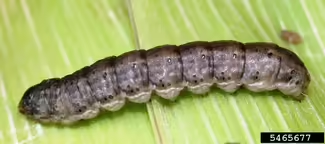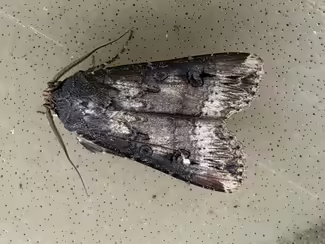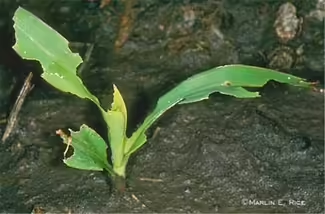
Corn is a cornerstone of agriculture in Illinois, playing a vital role in both the state's economy and the livelihoods of its farmers. As planting season begins, it's crucial to be aware of potential threats to corn crops, one of the most significant being the black cutworm, Agrotis ipsilon. This pest can cause substantial damage to young corn plants, leading to reduced yields and economic losses. This two-part blog series will delve into the world of black cutworm, exploring its biology, behavior, and the impact it has on corn production. Farmers can better prepare and implement effective management strategies to protect their crops by understanding this pest. Part one will focus on understanding black cutworm: what it is, how to identify it, and the damage it can inflict on corn plants.
It is important to first understand corn production in Illinois and its significance to agriculture in the state. According to the United States Department of Agriculture National Agricultural Statistics Service (USDA-NASS), approximately 10.65 million acres of corn were grown for grain in Illinois in 2024, with a statewide average yield of 217 bushels per acre. At an average price of $4.30 per bushel, the value was approximately $9.9 billion. Many counties across Illinois had average yields above 200 bushels per acre. In 2023, Stark (234.1), Henderson (229.7), Carroll (229.5), Mercer (226.6), and Macon (225.3) counties had the highest average yields in Illinois. But how many acres of corn will be planted in Illinois this year? The annual Prospective Plantings report from USDA-NASS indicates approximately 11.1 million acres of corn will be planted in Illinois in 2025, up from 10.8 million in 2024.
Various cutworm species are present in the Midwest and across North America, but black cutworm presents the most serious threat to corn growers. Cutworms undergo a lifecycle process known as complete metamorphosis. The process has four stages: egg, pupa, larva, and adult. Adult cutworms are moths and can lay more than 1,000 eggs in their lifetime, mostly in clusters, according to the University of Missouri. But where do they come from? How do they get here? While some pupae and larvae can overwinter in the southern parts of Illinois, the majority migrate north from the southern United States and Mexico as moths using winds that fuel Spring storms. Moths are a grayish-brown color with black markings on the wings and a one to two-inch wingspan. Female adults will lay their eggs starting in April and May in low spots of fields or in areas with tall grass, dense weeds, or areas with minimal tillage. Fields that are tilled late, are planted in corn following soybeans, or are late planted, can also be more likely to be damaged.
The larvae will hatch roughly five to ten days after being laid. Larvae can grow up to one and a half inches long and be gray or black. Larvae will always have a broad, light gray band that runs down the middle of the back and paired tubercles on the upper side of the body. The larval stage lasts approximately 28 to 35 days before the pupal stage. The larval stage is when the most severe damage can occur to corn and other plants.
Stem damage and leaf damage are the most common signs of cutworms. The type of feeding pattern depends on soil moisture and plant size. According to Penn State Extension, when soil moisture is adequate, larvae will burrow under the soil surface during the day and emerge at night to begin feeding. If the soil is drier, the larvae will not emerge but feed on the plant below the soil surface. Throughout its lifespan, a larva can cut four to five corn plants. Large-scale infestations can cause approximately 10-18% loss in a field, mostly confined to a single area.
The typical sign of damage from black cutworms is a plant being cut off right at the soil surface. Sometimes, the larvae drag the cut plant under the soil surface to continue feeding. Once host plants such as chickweed or mustard are no longer in the field, the larvae will begin feeding on corn plants. Early signs of feeding are small holes on the leaves, a typical sign of young larvae. Larvae will generally target corn plants less than 15 inches tall, but some shoulder-height plants have been cut. Once a plant gets too tall, the larvae typically bore into the stem below the soil surface. This could cause a decrease in water and nutrient uptake, causing the plant to wilt.
This blog post is the first in a two-part series on black cutworm and its impact on corn growers. While it may be a relatively small insect, it can significantly impact corn production. This post discussed the lifecycle of black cutworms, how they migrate to Illinois, the physical characteristics of adult moths and larvae, and typical signs of damage from cutworms. The second part will review the economic threshold and management practices to reduce plant and yield losses.
For further reading, visit the following links:
- Black Cutworm (Illinois Extension)
- Black Cutworm (Iowa State Extension)
- Black Cutworm (Penn State Extension)
- Black Cutworm (Purdue Extension)
- Black Cutworm in Missouri (University of Missouri Extension)
- 2023 Illinois Corn Yield Estimates (USDA-NASS)
- 2024 State Agriculture Overview-Illinois (USDA-NASS)
- 2025 Prospective Plantings (USDA-NASS)




